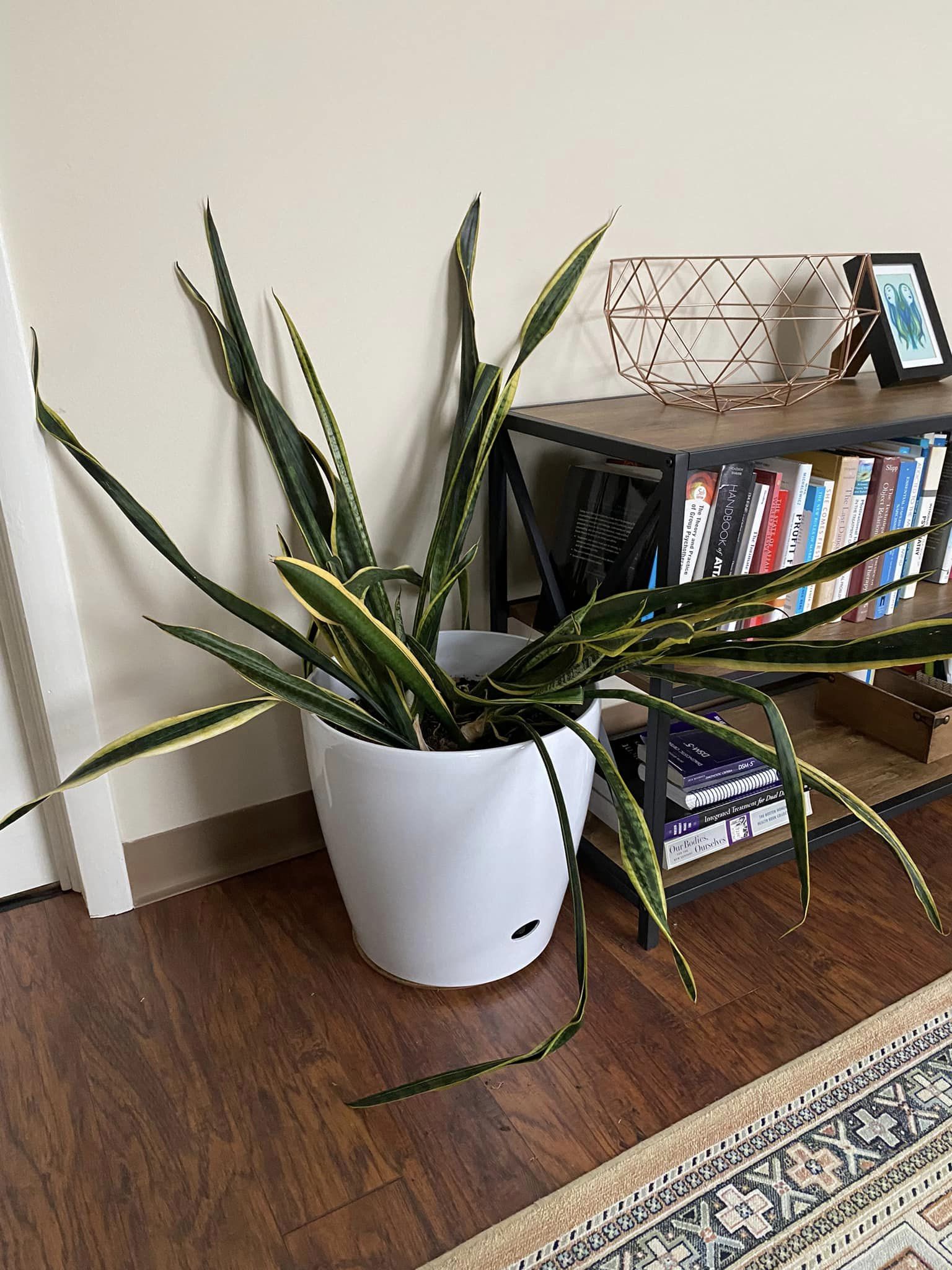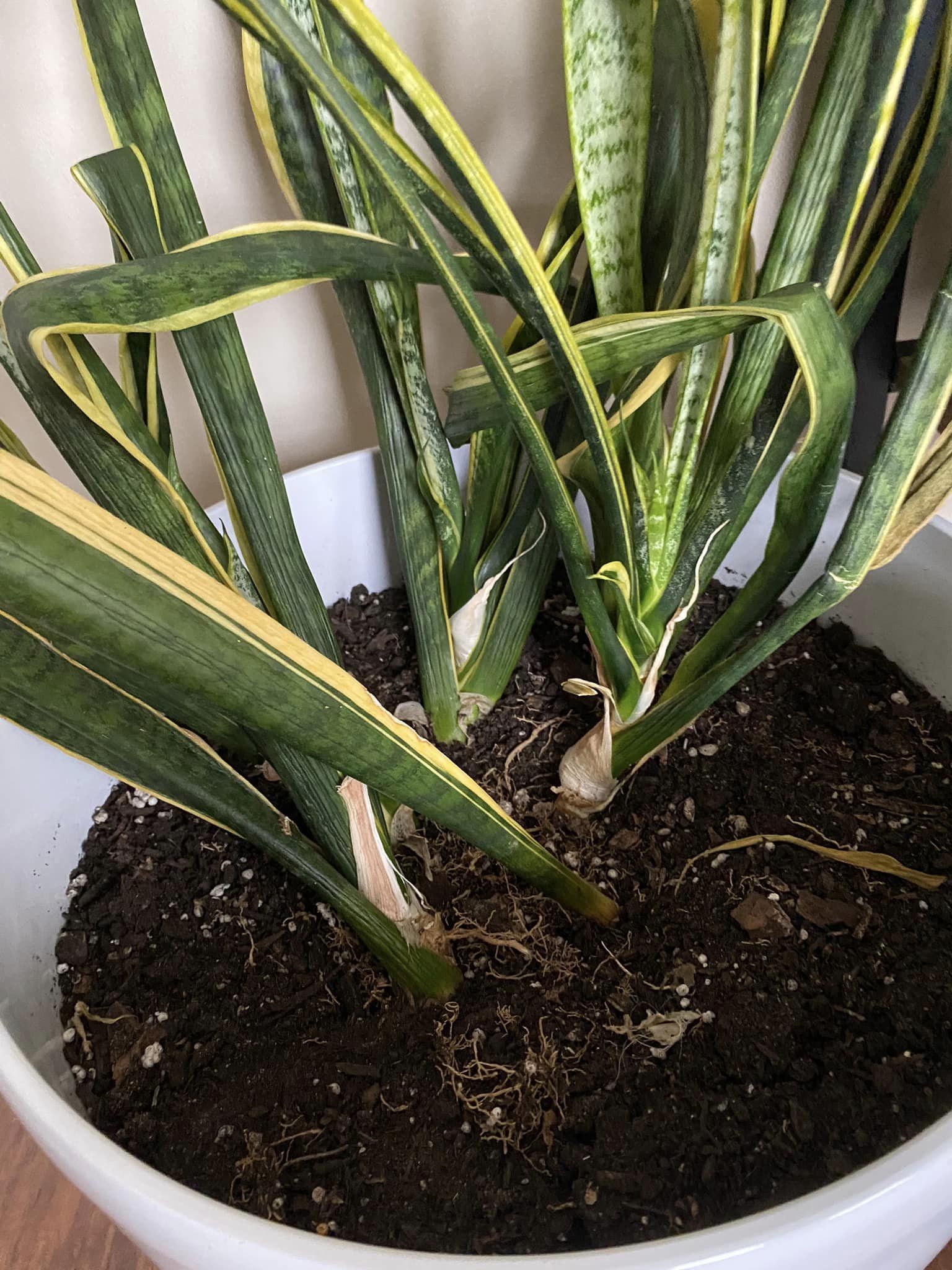You know something is up with your Snake plant if its dark green, sword-like, thick, fleshy, upright leaves are drooping. Typically, its leaves shoot up and grow vertically, a characteristic that plays a role in its distinct appearance.
Why is your snake plant drooping? A drooping snake plant could be due to several reasons. It might be receiving too much or too little water, experiencing root rot, or lacking proper drainage. Insufficient light or excessively low temperatures can also cause drooping.
Checking and adjusting watering, light, and temperature conditions can help revive the snake plant’s health and prevent further drooping.
Knowing the cause will help you save your plant, as the root cause will dictate the appropriate response. Read on to know how you can easily fix your snake plant drooping.
Why Is My Snake Plant Drooping?
These are the likely reasons your Snake plant is drooping.
1. Underwatering
The Snake plant’s native home of tropical West Africa is hot, dry, and rocky, so this plant doesn’t need a lot of water to flourish. However, when was the last time you watered your Snake plant? Your plant is probably thirsty if its leaves start drooping.
This is a common cause of a drooping Snake plant. In summer and Spring, when the plant is actively growing, water it every two weeks or when the soil mix is 3 to 4 inches dry.
When winter comes, and the light gets lower and temperatures cooler, water your Snake plant after 3 or 4 weeks.
Related Posts:
- How To Make Snake Plants Grow Taller And Straight
- How to Care for Indoor Snake Plants
- Why are my succulent leaves falling off
2. Overwatering
If you haven’t underwatered your Snake plant, you may have given it too much water and caused all sorts of problems, including drooping. Snake plants require less water compared to other typical houseplants, so you must exercise caution to avoid overwatering them.
Your Snake plants will suffer if you constantly water them, as the soil will stay moist, leading to yellowing or floppy leaves. To avoid overwatering your Snake plant, ensure the soil completely dries before the next watering session.
Also, do not stick to a stringent watering routine. Instead, alter the sessions based on the temperatures, light, humidity, air conditioning, heating, and season.
Read More: Why Is My Snake Plant Turning Yellow
3. Insufficient Light
A Snake plant’s ability to tolerate low-light conditions is impressive. However, your plant will have a tough time manufacturing food without enough light, and this could leave the leaves droopy, soft, and pale. The best light for Snake plants is bright, indirect light, as intense, direct light can scorch their leaves.
Prolonged periods of complete darkness can negatively affect this plant’s growth. This is why you should provide it with artificial light sources, such as fluorescent or grow lights if you place a Snake plant in a room with very little natural light.
If your Snake plants have variegated leaves (leaves with yellow or white stripes), they will require slightly more light compared to solid green varieties. The brighter conditions help maintain their vibrant coloration since the lower light can cause the variegation to fade.
4. Temperature Stress
To grow a healthy Snake plant, keep the temperatures between 60°F (15°C) and 85°F (29°C) because extreme heat or cold can cause stress and lead to drooping. Therefore, if you find the leaves drooping, your plant is likely in shock due to rapid temperature changes.
5. Nutrient Deficiency
A snake plant leaves falling over might also have nutrient deficiencies like nitrogen, iron, phosphorus, magnesium, and potassium. Your Snake plants are more susceptible to nutrient deficiencies if they have suffered issues like overwatering, underwatering, root rot, rootbound, and fungus gnats.
6. Root Bound
A Snake plant eventually outgrows its container or pot and must be repotted. If you don’t, it will suffer problems like drooping with yellow leaves due to the inability to receive enough air and nutrients. Once your Snake plants outgrow their pots, they will circle around them, causing them to tangle and restrict their growth.
A little root bound doesn’t impact your Snake plant, but excessive root bound will harm the plant.
7. Pests or Diseases
Your Snake plant might also be plagued with pests or diseases if the leaves are limp. Search for pests like mealybugs, spider mites, scale insects, or fungal infections such as root rot or leaf spot.
8. Root Rot
A Snake plant suffering from root rot has discolored and mushy roots and wilting leaves. You will likely face this problem if you overwater or grow your succulents in poorly-drained pot soil.
Inspect your Snake plants’ roots for root rot. Your plants are infected if the roots are soft, red, or brown.
9. Poor Drainage
Did you plant your Snake plant in the correct soil (well-draining, loose soil)? If you don’t, your plant may suffer issues, including root rot leading to drooping leaves and death.
Also Read: How to make succulent soil
10. Transplant Shock
When transplanting your Snake plant from one container or area to another, expect it to undergo stress or trauma. Fortunately, transplant shock is short-lived, and your plant will recover shortly.
However, if you mismanage this process, this phenomenon can affect the health and survival of the plant. Transplanting disrupts a plant’s ability to take up water and nutrients.
Additionally, it exposes it to different environmental conditions, such as temperature, light, and humidity changes, which can further stress the plant.
Also Read: Are snake plants toxic to dogs?
How To Save A Drooping Snake Plant
As I said earlier, in order to save your drooping Snake plant, you must know the cause of the problem. So, after identifying the root cause, adopt the strategy that will save your plant.
Take steps to take to save your drooping Snake plant:
a) Adjust The Watering
Rather than relying on a fixed watering schedule that can lead to overwatering or underwatering, let the soil moisture guide you. Use the finger test or a moisture meter to determine if you should water your Snake plants or wait longer.
If your Snake plant is severely overwatered, gently remove it from its current pot, trim away any rotting or damaged roots, and replant it in a suitable container with well-draining soil.
On the other hand, if you are dealing with an underwatered Snake plant, fill a container or basin with room-temperature water. Gently remove your Snake plant from its pot and place it in the water for about 30 minutes to give the roots a chance to absorb moisture. Avoid submerging the entire plant if it has a rosette shape or compact leaves to avoid rot.
b) Address Drainage Issues
While your succulents can grow in pots without drainage holes, that puts them at risk of root rot by letting the roots sit in water. So, give your Snake plants the best chance to thrive by planting them in well-draining containers.
Related Post: How To Water Succulents Without Drainage
If your current pots don’t have drainage holes, repot the Snake plant into a well-draining soil mix. Alternatively, add sand or perlite to boost drainage.
c) Provide Adequate Lighting
Move your Snake plant to a location that receives more indirect sunlight, ideally near a window with filtered or indirect sunlight. Alternatively, use fluorescent or LED grow lights specifically designed for plants if natural light is limited in your home. Position the lights a few feet above the plant and keep them on for 12 to 14 hours a day.
Also, keep your Snake plant away from areas with consistently low light levels, such as corners or rooms with minimal windows. These areas don’t provide enough light for the plant to thrive.
Once you adjust the lighting conditions, observe how your Snake plant responds. Over time, you should see improvements in the foliage as the plant adapts to the increased light levels.
d) Avoid Sudden Temperature Changes
Protect your Snake plants from drastic temperature shifts by keeping them away from direct sunlight during hot summer days or near windows during cold winter nights. Also, protect them from drafts, air conditioning vents, or heating sources.
Apart from stable temperatures, Snake plants also need good airflow.
e) Address Pests
Look closely at the leaves, especially the undersides and near the plant base. Look for signs of pests, such as tiny crawling insects, webs, or small white cottony masses.
Do not forget to inspect the soil surface because some pests can hide in the soil or plant debris. Look for signs of crawling insects, eggs, or larvae. A magnifying glass will help you get a closer look making it easier to spot small insects or their eggs.
Take measures to get rid of pests if you find them. Remove small pest infestations by wiping the affected areas using a damp cloth. For more extensive infestations, organic insecticidal soaps or horticultural oils specifically formulated for indoor plants will help.
f) Prune Your Snake Plant’s Foliage
Pruning isn’t necessary if only a few leaves are drooping, but what if you are dealing with severely drooping or yellow leaves? In that case, take out clean and sharp gardening shears, then cut off the affected leaves at the base to encourage new growth and avoid damaging the healthy foliage.
Trim the affected leaves at the base, near the soil level, ensuring you make clean cuts to avoid jagged or torn edges. Also, disinfect the blades with rubbing alcohol or a mild bleach solution to avoid spreading diseases or pests.
Frequently Asked Questions about Falling Snake Plant Leaves
Should I Cut Off Drooping Snake Plant Leaves?

Yes, you should cut off drooping snake plant leaves. Drooping leaves are typically a sign of underwatering, overwatering, or root rot. Trimming the affected leaves will not only improve the plant’s appearance but also promote new growth. Be sure to address the underlying watering issues to prevent further leaf drooping.
What to do with drooping snake plant leaves?
You can propagate snake plant leaves that look healthy and discard any leaves that have evidence of rot. Rotten snake plant leaves will not recover to grow vertically again.
Summary
Drooping Snake plant leaves don’t necessarily mean you will lose your plant. With a few strategies and knowing the cause of the issue, you can save your plant. Recovery time is paramount. So, after making the necessary adjustments to revive your plant, handle it gently and give it time to bounce back.

Hey there, fellow plant enthusiasts! I’m Rachel, the green-thumbed writer behind Rooted In Garden. With a deep-rooted love for all things botanical, I’ve made it my mission to help you cultivate a thriving collection of houseplants. As a devoted plant parent myself, I understand the joys and challenges that come with nurturing these leafy wonders. Whether you’re a succulent aficionado, an orchid enthusiast, or simply adore all potted flora, join me on this journey as we explore the secrets to growing and caring for our beloved green companions. Together, let’s create a flourishing oasis indoors.


